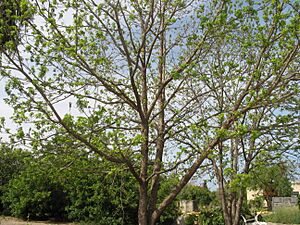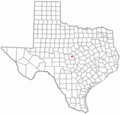San Saba, Texas facts for kids
Quick facts for kids
San Saba, Texas
|
|
|---|---|
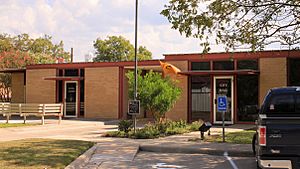
San Saba City Hall
|
|
| Nickname(s):
Copper-9
|
|
| Motto(s):
"The Pecan Capital of the World"
|
|
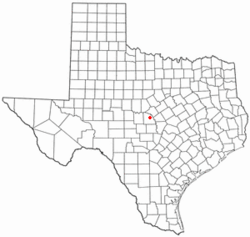
Location of San Saba, Texas
|
|
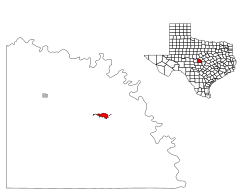 |
|
| Country | United States |
| State | Texas |
| County | San Saba |
| Area | |
| • Total | 2.71 sq mi (7.02 km2) |
| • Land | 2.71 sq mi (7.02 km2) |
| • Water | 0.00 sq mi (0.00 km2) |
| Elevation | 1,207 ft (368 m) |
| Population
(2020)
|
|
| • Total | 3,117 |
| • Density | 1,150.6/sq mi (444.3/km2) |
| Time zone | UTC-6 (Central (CST)) |
| • Summer (DST) | UTC-5 (CDT) |
| ZIP code |
76877
|
| Area code(s) | 325 |
| FIPS code | 48-65648 |
| GNIS feature ID | 2413254 |
| Website | City of San Saba, Texas |
San Saba is a small city in Texas, United States. It is the main town and county seat of San Saba County, Texas. The city was founded in 1854. It got its name from the nearby San Saba River and from a saint named Sabbas the Sanctified. In 2010, about 3,099 people lived there.
Contents
Where is San Saba Located?
San Saba is a city in Texas. It covers an area of about 2.71 square miles (7.02 square kilometers). All of this area is land. The city is located about 105 miles (169 km) northwest of Austin. It is also about 141 miles (227 km) north of San Antonio.
San Saba's Climate
The weather in San Saba is usually hot and humid in the summer. Winters are generally mild to cool. This type of weather is called a humid subtropical climate. It means the area gets a lot of rain and has warm temperatures for most of the year.
Who Lives in San Saba?
| Historical population | |||
|---|---|---|---|
| Census | Pop. | %± | |
| 1860 | 111 | — | |
| 1870 | 168 | 51.4% | |
| 1880 | 598 | 256.0% | |
| 1890 | 697 | 16.6% | |
| 1920 | 2,011 | — | |
| 1930 | 2,240 | 11.4% | |
| 1940 | 2,927 | 30.7% | |
| 1950 | 3,400 | 16.2% | |
| 1960 | 2,728 | −19.8% | |
| 1970 | 2,555 | −6.3% | |
| 1980 | 2,850 | 11.5% | |
| 1990 | 2,626 | −7.9% | |
| 2000 | 2,637 | 0.4% | |
| 2010 | 3,099 | 17.5% | |
| 2020 | 3,117 | 0.6% | |
| U.S. Decennial Census | |||
Population in 2020
In 2020, the 2020 United States census counted 3,117 people living in San Saba. There were 1,021 households and 666 families. The population density was about 1,150 people per square mile.
Here's a look at the different groups of people living in San Saba in 2020:
| Group | Number of People | Percentage |
|---|---|---|
| White (NH) | 1,517 | 48.67% |
| Black or African American (NH) | 98 | 3.14% |
| Native American (NH) | 12 | 0.38% |
| Asian (NH) | 16 | 0.51% |
| Pacific Islander (NH) | 1 | 0.03% |
| Mixed Race (NH) | 57 | 1.83% |
| Hispanic or Latino | 1,416 | 45.43% |
| Total | 3,117 |
About 22% of the people were under 18 years old. About 16% were 65 years or older. The average age was around 35 years.
Population in 2010
The census in 2010 showed that 3,099 people lived in San Saba. The city had about 1,008 households. Most households were families.
- About 27% of the people were under 18 years old.
- About 23% were 65 years or older.
- The average age was 39 years.
San Saba's Economy
Pecans are a very important crop in San Saba. This is largely thanks to a man named Edmund E. Risien. He moved to San Saba County in 1874. He spent his life working to improve the native pecan nuts.
Risien started the West Texas Pecan Nursery. It was located where the San Saba River and Colorado River meet. A special tree, known as the "Mother Pecan Tree," was in the middle of this nursery. This tree helped create many great types of pecans. Some of these types include the San Saba Improved and Texas Prolific.
Risien sold his pecans to famous people and companies. These included Queen Victoria of the United Kingdom and the Post Cereals Co. Because of his work, San Saba County is known as the "Pecan Capital of the World."
Education in San Saba
The San Saba Independent School District serves the students in San Saba.
- San Saba Elementary teaches students from kindergarten to 4th grade.
- San Saba Middle School teaches students from 5th to 8th grade.
- San Saba High School teaches students from 9th to 12th grade.
In 2013, the school district opened two new buildings. One was a new elementary school. The other building had science labs for the high school.
Famous People from San Saba
- M. King Hubbert, a well-known geologist (someone who studies rocks and the Earth).
- Tommy Lee Jones, a famous actor.
- Thomas Stewart, an opera singer.
Images for kids
See also
 In Spanish: San Saba (Texas) para niños
In Spanish: San Saba (Texas) para niños


